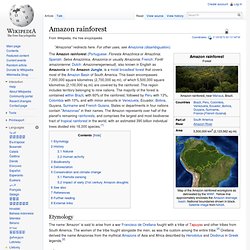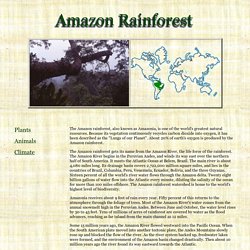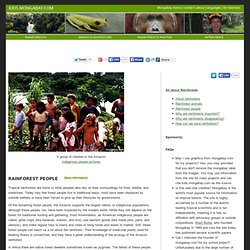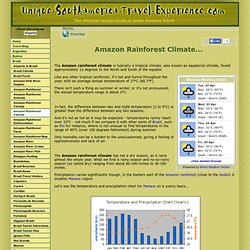

Amazon Rainforest Facts for Kids. Amazon rainforest. Etymology The name 'Amazon' is said to arise from a war Francisco de Orellana fought with a tribe of Tapuyas and other tribes from South America.

Amazon rainforest. Save The Amazon Jungle. Amazon Rainforest. The Amazon rainforest, also known as Amazonia, is one of the world's greatest natural resources.

Because its vegetation continuously recycles carbon dioxide into oxygen, it has been described as the "Lungs of our Planet". About 20% of earth's oxygen is produced by the Amazon rainforest. The Amazon rainforest gets its name from the Amazon River, the life force of the rainforest. The Amazon River begins in the Peruvian Andes, and winds its way east over the northern half of South America. It meets the Atlantic Ocean at Belem, Brazil. Amazonia receives about 9 feet of rain every year. Rainforest Facts. Rainforest Information for Kids. Facts About the Amazon Rainforest Animals. Amazon rainforest people. The Rainforest: People, Animals and Facts. Rainforest people. Of the remaining forest people, the Amazon supports the largest native, or indigenous populations, although these people, too, have been impacted by the modern world.

While they still depend on the forest for traditional hunting and gathering, most Amerindians, as American indigenous people are called, grow crops (like bananas, manioc, and rice), use western goods (like metal pots, pans, and utensils), and make regular trips to towns and cities to bring foods and wares to market. Still, these forest people can teach us a lot about the rainforest. Their knowledge of medicinal plants used for treating illness is unmatched, and they have a great understanding of the ecology of the Amazon rainforest. In Africa there are native forest dwellers sometimes known as pygmies. AMAZON RAINFOREST CLIMATE. The Amazon rainforest climate is typically a tropical climate, also known as equatorial climate, found approximately 12 degrees to the North and South of the equator.

<a href=" alt="7 day Manaus Weather, Brazil weather">7 day Manaus Weather, Brazil weather</a> provided by <a href=" Weather Online</a> Powered by World Weather Online Like any other tropical rainforest, it's hot and humid throughout the year, with an average annual temperature of 27°C (80.7°F). There isn't such a thing as summer or winter, or it's not pronounced, the annual temperature range is about 2°C.
In fact, the difference between day and night temperature (2 to 5°C) is greater than the difference between any two seasons. And it's not as hot as it may be expected - temperatures rarely reach over 33°C - not much if we compare it with other parts of Brazil, such as Rio for instance, where is not unusual to find temperatures in the range of 40°C (over 100 degrees Fahrenheit) during summer. Weather in Manaus. Amazon Rainforest Climate. Due to environmental degradation, climatic conditions around the earth's forests including the Amazon rainforest climate have started showing changes.

GCSE Bitesize: Characteristics and climate. The weather in the amazon rainforest. Bad weather. BBC Nature - Amazonian wildlife. 10 Bizarre Creatures of the Amazon Rainforest. Animals The fast-disappearing Amazon rainforest harbors some amazing creatures.

Most of us have heard of vampire bats, piranhas and the anaconda, but among the forest’s inhabitants are weird and wonderful animals just as bizarre as the more famous ones, if not more so. Here are 10 of the most bizarre Amazon rainforest animals you’ve likely never heard of. This relative of the raccoon has golden fur and a tail that can grip branches.
Also called the honey bear, it lives in trees and mainly eats fruit. Dwelling in murky rivers, the electric eel delivers hundreds of volts that can stun a human. These brightly colored frogs are among the most toxic creatures on earth. The world’s largest ant grows to the size of your pinky and has a bite to match. When fleeing from predators, this reptile runs along the surface of water such as a pond or stream. Eschewing the typical bat diet of insects, the world’s largest species of bat has claws like an osprey’s. Amazon Wildlife. Recent news articles on Amazon biodiversity Oil or rainforest: new website highlights the plight of Yasuni National Park (03/20/2014) A new multimedia feature story by Brazilian environmental news group, ((o))eco, highlights the ongoing debate over Yasuni National Park in Ecuador, arguably the most biodiverse place on the planet.

Scientist discovers a plethora of new praying mantises (pictures) (03/19/2014) Despite their pacific name, praying mantises are ferocious top predators with powerful, grasping forelimbs; spiked legs; and mechanistic jaws. In fact, imagine a tiger that can rotate its head 180 degrees or a great white that blends into the waves and you'll have a sense of why praying mantises have developed a reputation. Several Amazonian tree frog species discovered, where only two existed before.